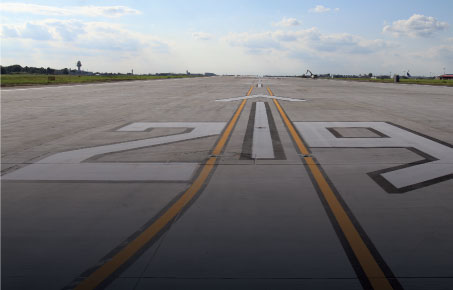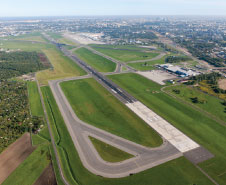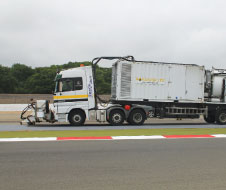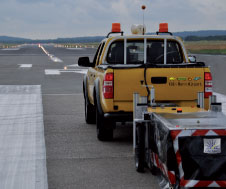
The repair of Runway 1 started in July 2010 and the 14-month project involved the replacement of the runway pavement together with the base course and the upgrade of all technical systems, allowing for a greater load bearing capacity and resistance. New centre line and edge lighting has also been installed.
While the redevelopment of the 2,860m runway was ongoing, all flights to and from Warsaw Chopin Airport made use of the larger 3,690m runway and Andrzej Ilków, Aerodrome Operations Safety Bureau Director, explained that “for almost the whole time of repair, there were no limitations and the work had no impact on airport operations”.
He continued: “The only disruptions to air traffic occurred during the work on the runway intersection in September 2010, when the airport had to be closed for larger planes. One of the biggest operations in Chopin Airport’s history, the work involved reshaping the longitudinal profile of the runway to remove the surface irregularity of up to 55cm in depth, which was too large in proportion to its length, leading to greater aircraft overloads and faster deterioration of runway pavement.”
To remedy this, 20,000 tonnes of bituminous mix were laid on the intersection over a period of just four days, requiring the input of almost 500 workers.
Ilków added: “The repair has improved the load bearing capacity of the runways, which will allow for accommodating regular flights of the world’s largest aircraft. This is especially important for the airport, since as of April 2012, Chopin Airport will serve as the base of LOT Polish Airlines’ B787 Dreamliner planes.”

Warsaw Chopin Airport is undertaking the reconstruction of Apron 3, and this project is due to be complete by the end of November.
CAT III ILS
As well as the resurfacing and strengthening of the runway and the addition of new lighting, the investment in the airfield extends to the repair of some sections of the taxiways. The airport is also in the middle of the reconstruction of Apron 3, and this project is due to be complete by the end of November. Also underway is the development of a new centralised fuel infrastructure, for which the tender process for the operator of the system began in September.
Ilków continued: “We are also preparing for the introduction of CAT III ILS. The Polish Air Navigation Services Agency will install the appropriate equipment and after the trials, we will officially become a Category III airport.”
Currently, Warsaw Chopin is the only CAT II ILS airport in Poland, but the upgrade to CAT III will allow the airport to safely receive aircraft in even the most difficult weather conditions.
Long-term plan

Ilków: “We are also preparing for the introduction of CAT III ILS. The Polish Air Navigation Services Agency will install the appropriate equipment and after the trials, we will officially become a Category III airport.”
Next summer, Poland will co-host the EURO 2012 European football championships and, although this will result in a sharp increase in passenger traffic in June and July, the current developments were always included in the airport’s long-term development strategy. According to UEFA forecasts, during the four-week tournament, Warsaw Chopin Airport can expect more than 100,000 additional passengers.
“Right from the start, UEFA officials declared that Warsaw Chopin Airport needed only small improvements to comply with tournament requirements, so it wasn’t necessary to take up any investments specifically for the championships. All current construction and repair projects are part of a long-term airport development programme, aimed at raising passenger service and air traffic handling standards in general,” Ilków said.
While an external project, which will see a rail extension provide easier access from the airport to the city centre, is set to be completed in March 2012, the airport itself has recently finalised various other projects, including the Terminal A extension and the construction of the Terminal A access roads network.

Roadgrip Ltd has recently used the TrackJet system at London Heathrow, London Stansted, Dublin and Manchester airports.
TrackJet makes millionaires
The English service and contracting company Roadgrip Ltd. recently cleaned its millionth square metre with the TrackJet system.
A huge variety of different and challenging jobs were carried out to reach this milestone, including: London Heathrow Airport (paint removal); London Stansted Airport (rubber removal); Dublin Airport (paint removal); and Manchester Airport (rubber removal and paint removal).
Other projects also undertaken include Silverstone F1 GP, RAF Lakenheath, and Glasgow Prestwick International Airport.
“The Trackjet System continues to provide a cost-effective, and a reliable system for rubber removal, paint removal and pavement retexturing,” said Richard Powell, commercial director, Roadgrip Ltd. “Trackjet’s real benefit is that whilst the evenness of treatment is controlled by the computer, our engineers are able to control the speed, rotation and pressure to deliver the appropriate degree of treatment in any given situation. We are able therefore to provide consistent surface treatment without damaging the substrate, effectively extending the life of our clients’ assets.”

In order to guarantee consistently good results and compliance with ICAO Annex 14, Cologne Airport decided on DALMAS, the patented measuring system of the Dortmund company DeWiTec.
Airfield lights: Testing with German high-tech
In the constantly growing cargo sector, Cologne Airport is Germany’s number two.
Aircraft land and take-off within minutes of each other around the clock.
Over 10,000 lights must be tested on-ground during continuous operation and replaced if needed. Maintenance specialist Jürgen Rader, responsible for the technical safety of all visual taxiing and landing aids in Cologne, has to schedule safe staff access to the runway for “target maintenance”.
In order to guarantee consistently good results and compliance with ICAO Annex 14, Rader’s department decided on DALMAS, the patented measuring system of the Dortmund company DeWiTec.
Since 2009, DALMAS has been used successfully to the complete satisfaction of the operator; it tests and documents all relevant visual taxiing and landing aids in the runway and taxiway area. Decisive was the fact that this is the only tool that measures reliably, not only at dawn or twilight, but during any light, and can therefore be used during low activity midday hours.







